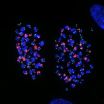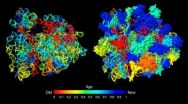(Press-News.org) LA JOLLA, CA----The well-being of living cells requires specialized squads of proteins that maintain order. Degraders chew up worn-out proteins, recyclers wrap up damaged organelles, and-most importantly-DNA repair crews restitch anything that resembles a broken chromosome. If repair is impossible, the crew foreman calls in executioners to annihilate a cell. As unsavory as this last bunch sounds, failure to summon them is one aspect of what makes a cancer cell a cancer cell.
A recent study from scientists at the Salk Institute for Biological Studies showed exactly how cells sense the possibility that their DNA is damaged as a first step to responding to the failure to divide properly. That study, published March 11 in Nature Structural and Molecular Biology, found that if cells take too long to undergo cell division, structures at the tips of their chromosomes, known as telomeres, send out a molecular SOS signal.
These findings have dual implications for cancer chemotherapy. First, they show how a class of anti-cancer drugs that slows cell division ---- known as mitotic inhibitors---- kills cells.This class includes the common chemotherapy drugs Vinblastine, Taxol and Velcade. More significantly, the findings suggest ways to make therapy with those inhibitors more potent.
"How mitotic inhibitors work as cancer therapy has been a 25-year-old question," says Jan Karlseder, a professor in Salk's Molecular and Cell Biology Laboratory and the study's senior author. "These drugs are widely used, but it was unclear why they actually kill cancer cells."
The Karlseder lab has long been fascinated by the roles played by telomeres in aging and cancer. Often described as the genomic equivalent of the plastic caps that keep shoelaces from fraying, telomeres form a protective protein/DNA cap on each end of linear chromosomes, masking those ends from vigilant but apparently myopic repair proteins, who might mistake exposed chromosome ends for broken DNA.
Initially, the group searched for specific proteins that might keep telomeres intact during cell division. To do so, they genetically eliminated candidate proteins one by one and then examined cells using fluorescence microscopy to detect whether telomeres became damaged. What they found was unexpected ---- namely, that any manipulation that crippled and prolonged cell division produced increased numbers of punctate telomere blobs indicative of "unprotected" telomeres.
Treating cells with mitotic inhibitors used in cancer chemotherapy did the very same thing. Those studies established a link between arrested mitosis, telomere perturbation and cell death.
They then confirmed that as cells stalled in mitosis, telomeric shoelace caps started to disintegrate. "Normally the ends of chromosomes are covered by the protein TRF2, which protects the telomere," says Makoto Hayashi, a postdoctoral fellow in the Karlseder lab and the study's first author. "But we found that, during mitotic arrest TRF2 dissociates from telomeres, exposing chromosome ends as damaged DNA. That likely activates a DNA damage signal."
The clincher came when the investigators found that the longer cells endured telomere distress, the more massively they induced what ought to be everyone's most treasured gene, the tumor suppressor p53.
"DNA damage signals occurring during mitotic arrest likely predispose cells to upregulate p53 in the following phase," says Hayashi. "This then either halts the cell cycle to enable DNA repair to occur or commits cells to a suicide pathway called 'apoptosis'."
Karlseder notes that p53 and proteins it mobilizes constitute the most frequently mutated pathway in cancer. "A functional p53 pathway is a healthy sign, as it is the cell's first responder to DNA breaks or telomere dysfunction," he says, "Without it, chromosomes could become unstable and could fuse to one another or break, leading to a loss of genome integrity and uncontrolled growth."
This work suggests novel strategies that could be used in combinatorial cancer chemotherapy regimes, which rely on the synergy between two or more drugs. The theory is that a multi-pronged approach might pack more of a wallop than a sledgehammer alone, as evidenced by the highly effective "triple cocktail" of drugs now used to treat AIDS.
"To make therapy more effective and reduce side effects, we might be able to use more moderate levels of mitotic inhibitors, which at high doses can cause severe side effects, paired with a different drug that sensitizes cells to the DNA damage response," says Karlseder. "That could improve the chances of catching 100 percent of the tumor cells."
Prior to this study telomeres were already celebrated for the fact that they regulate aging by acting as a cellular clock, which ticks down a cell's age. "Every time a cell divides, a little bit of the telomere cap is lost until it is gone, signaling that cells cannot divide anymore," explains Karlseder. "This limitation ensures that cells do not become immortal or cancerous."
Recent studies show, however, that among their other insidious activities, cancer cells figure out how to set back the telomere clock and keep them immortal. "They do this by switching on pathways that specifically lengthen telomeres," says Karlseder. "These pathways therefore represent an important potential target for therapy."
Also contributing to this study were Anthony Cesare, of the Karlseder Lab; James Fitzpatrick, director of Salk's Waitt Advanced Biophotonics Core Facility; and Eros Lazzerini-Denchi, of The Scripps Research Institute in La Jolla.
INFORMATION:
Funding for the study came from the National Institutes of Health, the Human Frontier Science Program and the Japan Society for the Promotion of Science.
About the Salk Institute for Biological Studies:
The Salk Institute for Biological Studies is one of the world's preeminent basic research institutions, where internationally renowned faculty probe fundamental life science questions in a unique, collaborative, and creative environment. Focused both on discovery and on mentoring future generations of researchers, Salk scientists make groundbreaking contributions to our understanding of cancer, aging, Alzheimer's, diabetes and infectious diseases by studying neuroscience, genetics, cell and plant biology, and related disciplines.
Faculty achievements have been recognized with numerous honors, including Nobel Prizes and memberships in the National Academy of Sciences. Founded in 1960 by polio vaccine pioneer Jonas Salk, M.D., the Institute is an independent nonprofit organization and architectural landmark.
Sending out an SOS: How telomeres incriminate cells that can't divide
Salk scientists' discovery explains how a class of chemotherapy drugs works
2012-03-13
ELSE PRESS RELEASES FROM THIS DATE:
Gaffney Hotel Lets Guests Earn More Points From Hilton HHonors
2012-03-13
The Hampton Inn Gaffney Hotel is offering a special promotion that lets guests earn more points from Hilton HHonors . Travelers who sign up for the More Points promotion will earn 1,000 Bonus Points per night plus 5,000 Bonus Points for every weekend stay for two nights or more for stays now through March 31, 2012. Special offers and rates are subject to availability; some restrictions may apply.
Among other Gaffney South Carolina hotels, the Hampton Inn Gaffney is a leading place to stay in the area. The property's features and amenities include:
- Free hot breakfast ...
Why do we see the man in the moon?
2012-03-13
There's something poetic about gazing up at the night sky, seeing the familiar face of the "Man in the Moon" who faithfully accompanies us through life. The synchronous rotation of the Moon taking the same amount of time to spin around its own axis as it does to revolve around Earth is what causes the Moon to "lock eyes" with Earth, resulting in one of its hemispheres constantly facing us. But is there a reason why this particular half of the Moon locked with Earth, or was it pure coincidence that it didn't "turn its back" on us?
Through careful analysis and simulations, ...
US citizenship may be determined at random
2012-03-13
The fate of nearly half a million immigrants hoping for U.S. citizenship may have been determined randomly, at least in part, according to a new study by a Michigan State University researcher who found the high-stakes civics test isn't a reliable measure of civics knowledge.
To be awarded citizenship, immigrants must correctly answer six of 10 questions on the verbally administered civics portion of the U.S. Naturalization Test, said Paula Winke, assistant professor of second language studies.
Questions are randomly selected by an immigration officer from a pool of ...
Super 8 Monroe NC Hotel Offers Close Lodging for Guests Attending Top Scholars Day at Wingate University
2012-03-13
Super 8 Monroe NC Hotel offers convenient lodging to students and their parents attending upcoming Top Scholars Days at Wingate University. The events will take place on campus March 17, 2012 and April 21, 2012; reservations are required. Top Scholars Day was created for admitted students to have the opportunity to chat with current students and professors at Wingate University. Attending students may compete for free tuition in the Tweet for Tuition Challenge.
"Situated only 5 miles from the school, our hotel near Wingate University is looking forward to welcoming ...
Researchers discover mechanism in cells that leads to inflammatory diseases
2012-03-13
Los Angeles, March 12, 2012 – Cedars-Sinai researchers have unlocked the mystery of how an inflammatory molecule is produced in the body, a discovery they say could lead to advances in the treatment of rheumatoid arthritis, Type 2 diabetes and numerous other chronic diseases that affect tens of millions of people.
The study, funded by the National Institutes of Health, is published online by the peer-reviewed journal Immunity and will appear in the March print edition.
The researchers identified for the first time the mechanism that leads to the production of the ...
Study of ribosome evolution challenges 'RNA World' hypothesis
2012-03-13
CHAMPAIGN, Ill. — In the beginning – of the ribosome, the cell's protein-building workbench – there were ribonucleic acids, the molecules we call RNA that today perform a host of vital functions in cells. And according to a new analysis, even before the ribosome's many working parts were recruited for protein synthesis, proteins also were on the scene and interacting with RNA. This finding challenges a long-held hypothesis about the early evolution of life.
The study appears in the journal PLoS ONE.
The "RNA world" hypothesis, first promoted in 1986 in a paper in the ...
Common North American frog identified as carrier of deadly amphibian disease
2012-03-13
AUDIO:
This is an audio recording of the distinctive "ribbit " call of the Pacific chorus frog (28 seconds long, MP3 file, WAV file available on request).
This noisy frog is a potent...
Click here for more information.
Known for its distinctive "ribbit" call, the noisy Pacific chorus frog is a potent carrier of a deadly amphibian disease, according to new research published today in the journal PLoS ONE. Just how this common North American frog survives chytridiomycosis ...
March/April 2012 Annals of Family Medicine tip sheet
2012-03-13
Four articles in the current issue draw attention to policy initiatives and implications of the rapidly changing U.S. health care environment. Collectively, they examine some of the challenges and opportunities facing the country following the 2010 passage of the Patient Protection and Affordable Care Act.
Researchers Project Cost of Family Health Insurance Premiums Will Surpass Household Income by 2033
Updating estimates of who will be able to afford health insurance in the future in light of the 2010 Patient Protection and Affordable Care Act that reformed health ...
Diacetylmorphine for opioid addiction cheaper and more effective than methadone
2012-03-13
Using injectable diacetylmorphine — the active ingredient in heroin — to treat chronic opioid addiction is cheaper and more effective than methadone, states an article in CMAJ (Canadian Medical Association Journal).
Methadone is the most common treatment for people who are dependent on opioids such as heroin, although research indicates that most people over time go back to using illicit drugs. The North American Opiate Medication Initiative, a randomized controlled trial, indicated that diacetylmorphine is more effective in keeping opioid-dependent people in treatment. ...
Largest ever study of childhood ALL shows improving survival
2012-03-13
A 21,626-person study published today in the Journal of Clinical Oncology found that the five-year survival rate for children and adolescents with acute lymphoblastic leukemia (ALL), the most common childhood cancer, improved from 83.7 percent in those diagnosed during the years 1990-1994, to 90.4 percent for those diagnosed in the years 2000-2005.
"The improved survival is due to using existing drugs better, not because of the introduction of new drugs. We're indebted to all the families who choose to join these clinical trials, allowing us to optimize these combinations," ...
LAST 30 PRESS RELEASES:
Pure bred: New stem cell medium only has canine components
Largest study of its kind highlights benefits – and risks – of plant-based diets in children
Synergistic effects of single-crystal HfB2 nanorods: Simultaneous enhancement of mechanical properties and ablation resistance
Mysterious X-ray variability of the strongly magnetized neutron star NGC 7793 P13
The key to increasing patients’ advance care medical planning may be automatic patient outreach
Palaeontology: Ancient tooth suggests ocean predator could hunt in rivers
Polar bears may be adapting to survive warmer climates, says study
Canadian wildfire smoke worsened pediatric asthma in US Northeast: UVM study
New UBCO research challenges traditional teen suicide prevention models
Diversity language in US medical research agency grants declined 25% since 2024
Concern over growing use of AI chatbots to stave off loneliness
Biomedical authors often call a reference “recent” — even when it is decades old, analysis shows
The Lancet: New single dose oral treatment for gonorrhoea effectively combats drug-resistant infections, trial finds
Proton therapy shows survival benefit in Phase III trial for patients with head and neck cancers
Blood test reveals prognosis after cardiac arrest
UBCO study finds microdosing can temporarily improve mood, creativity
An ECOG-ACRIN imaging study solves a long-standing gap in metastatic breast cancer research and care: accurately measuring treatment response in patients with bone metastases
Cleveland Clinic presents final results of phase 1 clinical trial of preventive breast cancer vaccine study
Nationally renowned anesthesiology physician-scientist and clinical operations leader David Mintz, MD, PhD, named Chair of the Department of Anesthesiology at the UM School of Medicine
Clean water access improves child health in Mozambique, study shows
Study implicates enzyme in neurodegenerative conditions
Tufts professor named Fellow of the National Academy of Inventors
Tiny new device could enable giant future quantum computers
Tracing a path through photosynthesis to food security
First patient in Arizona treated with new immune-cell therapy at HonorHealth Research Institute
Studies investigate how AI can aid clinicians in analyzing medical images
Researchers pitch strategies to identify potential fraudulent participants in online qualitative research
Sweeping study shows similar genetic factors underlie multiple psychiatric disorders
How extreme weather events affect agricultural trade between US states
Smallholder farms maintain strong pollinator diversity – even when far from forests
[Press-News.org] Sending out an SOS: How telomeres incriminate cells that can't divideSalk scientists' discovery explains how a class of chemotherapy drugs works



